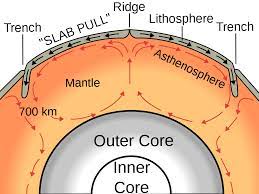The flow of high heat associated with oceanic ridges proves the existence of “Convection Currents in the Mantle”. These currents are believed to be responsible for the movement of crustal plates. The idea of convection currents was first suggested by a British geologist A. Holmes in 1927 when he tried to explain the driving mechanism for continental drift. Holmes proposed that sub-crustal convection currents dragged the two halves of the original continent apart. The mountain chains were formed on the front portion of the moving land masses where the currents were descending, and the ocean floor was developed on the site of the gap where the currents were ascending.

It is generally accepted that most of the mantle is hot-solid. Seismology suggests that the asthenosphere is partly molten (temperature about 1200 degrees Celsius). Due to the unequal distribution of heat, convection currents are generated in it. Under mid-oceanic ridges, the ascending hot plume spreads laterally. As it spreads away it cools, solidifies, and becomes attached to the oceanic plates. At trenches, the cold plume sinks back into the mantle where it is reheated. Thus the cycle of convection is completed. This convection transport imparts motion to the crustal plates.
Thus the convection current hypothesis has provided an important mechanism for explaining the continental drift, seafloor spreading, and plate tectonics.
to be continued……